Bathroom Moroccan Tile Design Ideas: Colors & Inspirations
Elevate your bathroom with the timeless charm of Moroccan tiles! From bold patterns to subtle elegance, these stunning tiles can add character, culture, and sophistication to any space. Moroccan tiles provide endless opportunities to create a unique and artistic bathroom, whether your vision is to create a tranquil retreat or a bold statement. Explore MyTyles collection of vibrant Moroccan tiles in a competitive price range!
By Eesha

Wed , Apr 02 , 2025

3 min read
Few design elements capture the perfect blend of tradition and modernity, like Moroccan tiles. For centuries, these tiles have captivated everyone with their bold patterns, rich colors, and intricate craftsmanship, rooted in centuries-old Islamic and Moorish artistry. These tiles are more than just decorative elements; they can tell a story of heritage, culture, and timeless design.
Today, their appeal extends beyond historical spaces, making a striking impact in modern homes, especially in bathrooms. Moroccan tiles seamlessly fuse tradition with contemporary style, effortlessly adapting to different aesthetics. They can be used in minimalist spaces that require a touch of warmth, as well as in eclectic interiors that are bursting with personality. Use them as accents on walls or floors, and you will never get the same level of depth and texture from any other material.
As we delve further into the topic, we will provide you with design ideas, color inspirations, and practical tips to help you incorporate Moroccan tiles into your bathroom in a beautiful way. At Mtyles, we can make your bathroom a striking, artful retreat with Moroccan tiles and their geometric precision.
How to Use Moroccan Tiles in Bathroom Design
Selecting the appropriate tile is the first step; the second is planning its placement and design. Moroccan tiles offer incredible versatility, whether you want to create a bold statement or introduce subtle decorative accents.
Accent Walls & Feature Walls in Bathroom
A Moroccan tile accent wall in the bathroom can serve as a stunning focal point. By positioning Moroccan tiles behind a vanity, bathtub, or shower area, you can create a dramatic statement that draws attention. To achieve balance, patterned Moroccan tiles can be paired with plain tiles, making sure that the design remains visually appealing. In the below image, you see Moroccan tiles behind the bathtub as an accent wall.
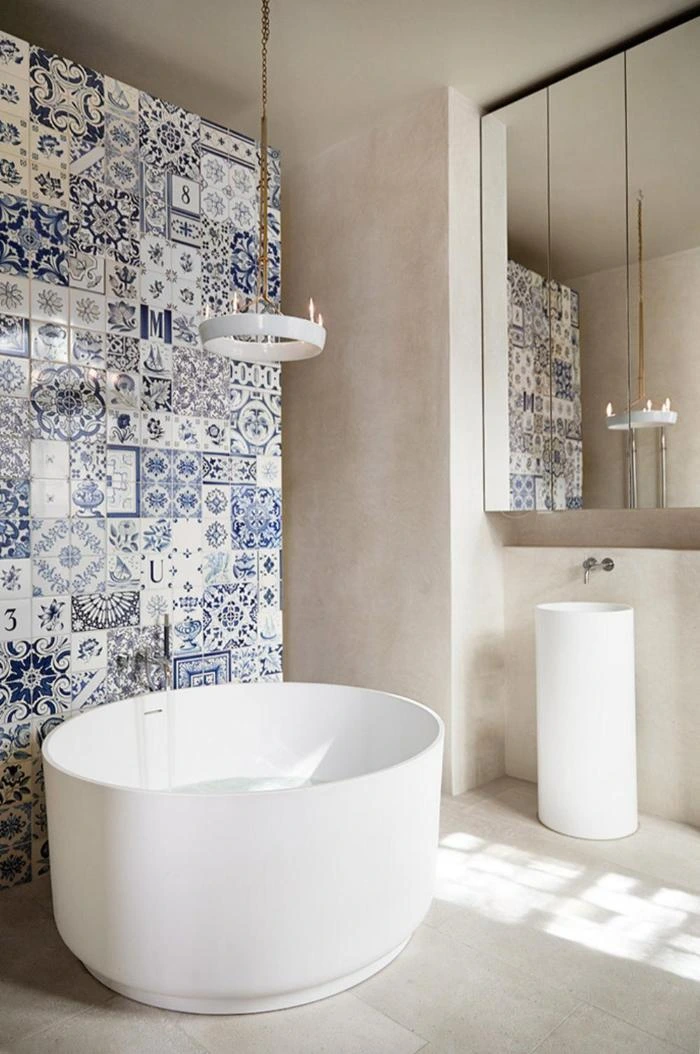
For a more immersive effect, a floor-to-ceiling Moroccan tile wall can create the illusion of a larger open space. The choice of color can also play a crucial role. Black and white Moroccan tiles can add a bold, classic contrast. Blue Moroccan tiles, on the other hand, evoke a serene, Mediterranean-inspired atmosphere. In the below image, there is a black-and- white Moroccan tiled statement wall in the bathroom.
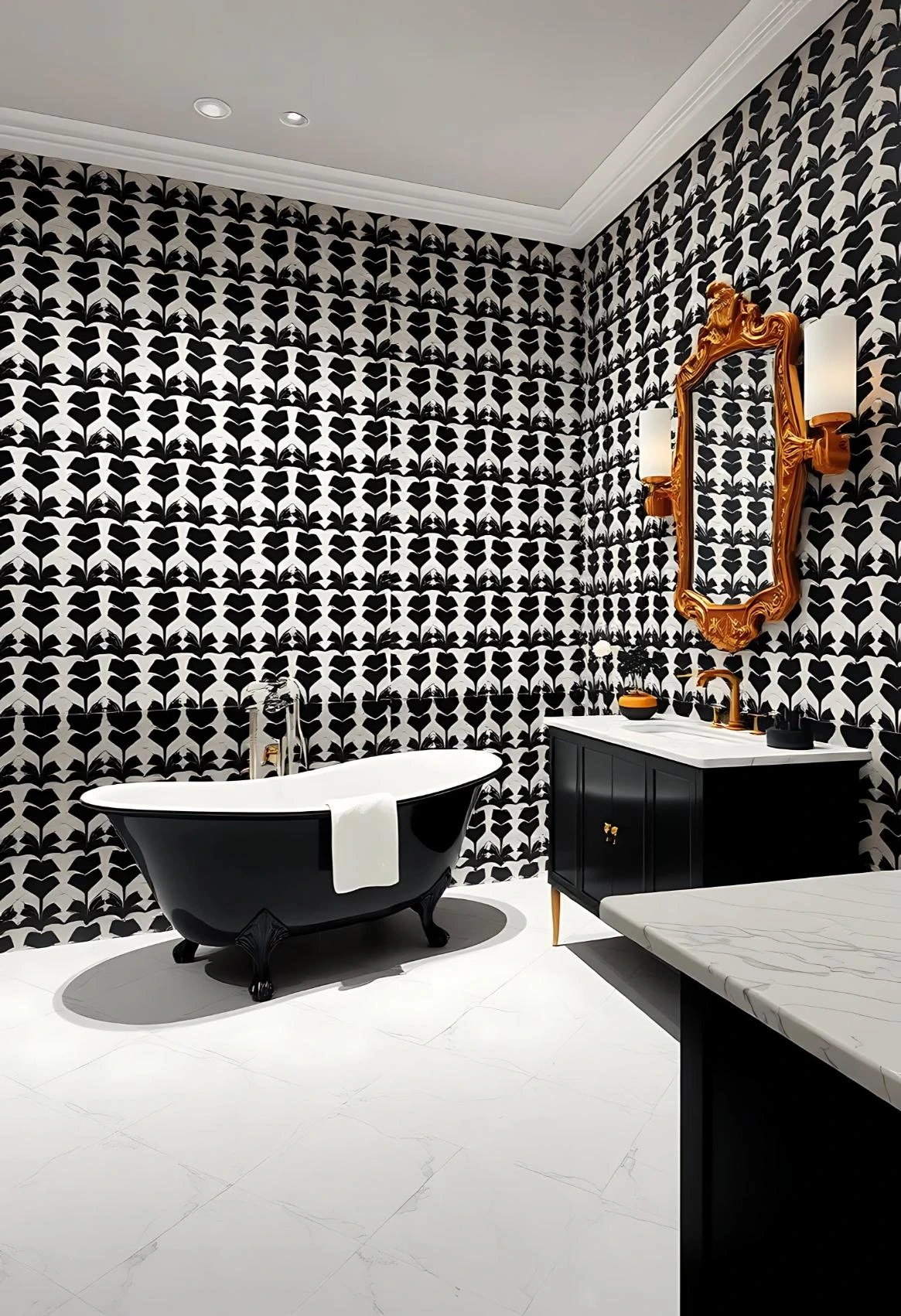
Flooring with Moroccan Tiles in Bathroom
Moroccan floor tiles in the bathroom can bring a luxurious, artistic feel. A full Moroccan-tiled floor can embrace a vintage charm while maintaining elegance. To have a more customised look, a Moroccan tile medallion placed at the center of the floor can act as an artistic focal point.
To maintain visual balance, bold and intricate Moroccan tiled floors can be paired with neutral walls and simple fixtures. Color selection can also enhance the overall mood. For instance, green Moroccan floor tiles introduce a nature-like warmth, while pink Moroccan floor tiles can create a soft, romantic ambiance. In the image below, you can see the vintage feel of a moroccan styled flooring in the bathroom.
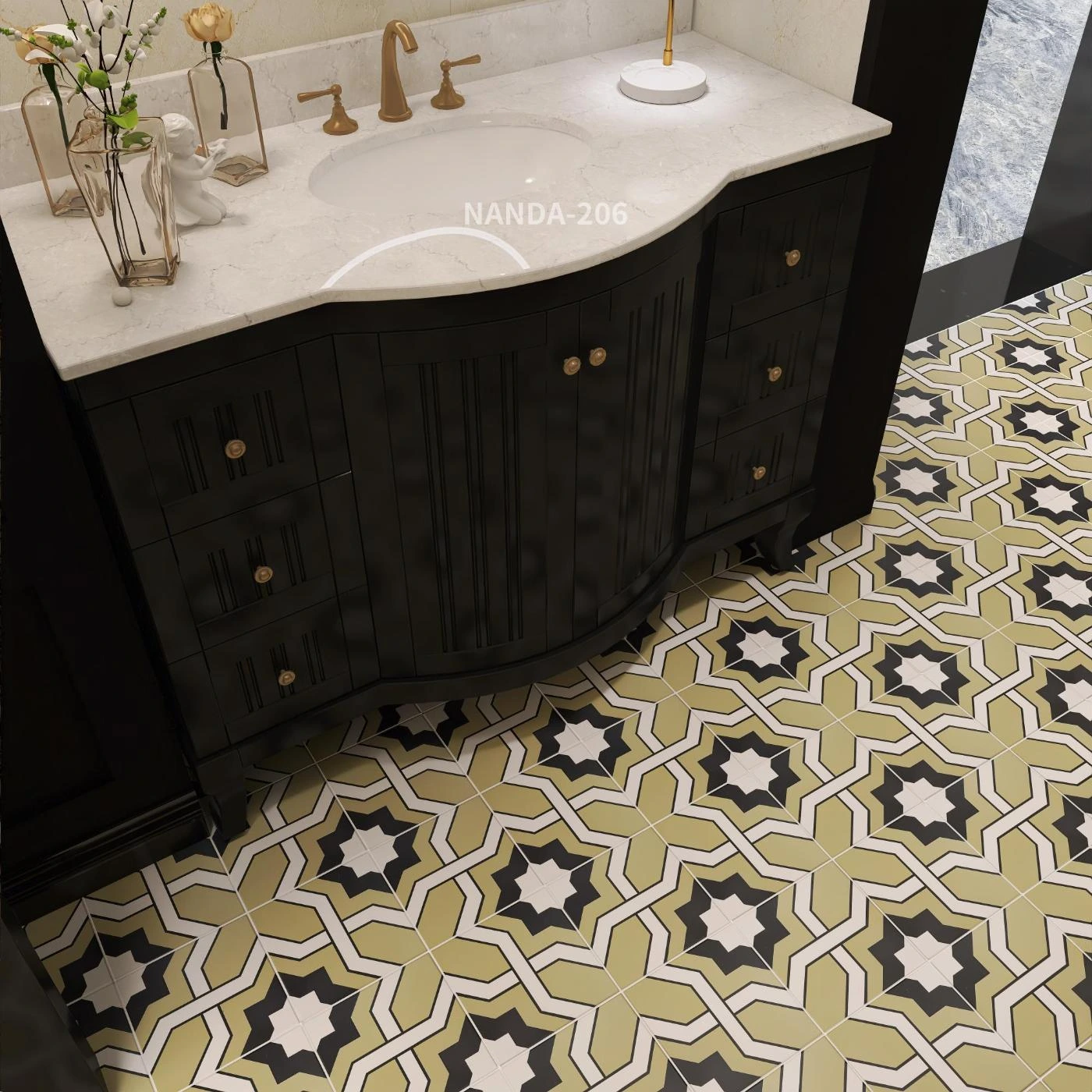
Shower Niches & Backsplashes in Bathroom
Bathroom with Moroccan tiles in shower niches and backsplashes is a subtle yet impactful way to incorporate intricate patterns. A shower niche lined with Moroccan tiles can provide an unexpected burst of color and artistry, transforming a functional space into a design feature.
Similarly, a vanity backsplash adorned with Moroccan tiles can add sophistication and texture, improving the sink area with a decorative yet practical touch. To further amp up the design, contrasting grout can be used to highlight the intricate patterns. You can go through our blog, Types of Bathroom Tiles to Create a Statement Backsplash. It can help you to have more ideas on creating stunning backsplashes. The picture below is of a vanity backsplash with a Moroccan design.
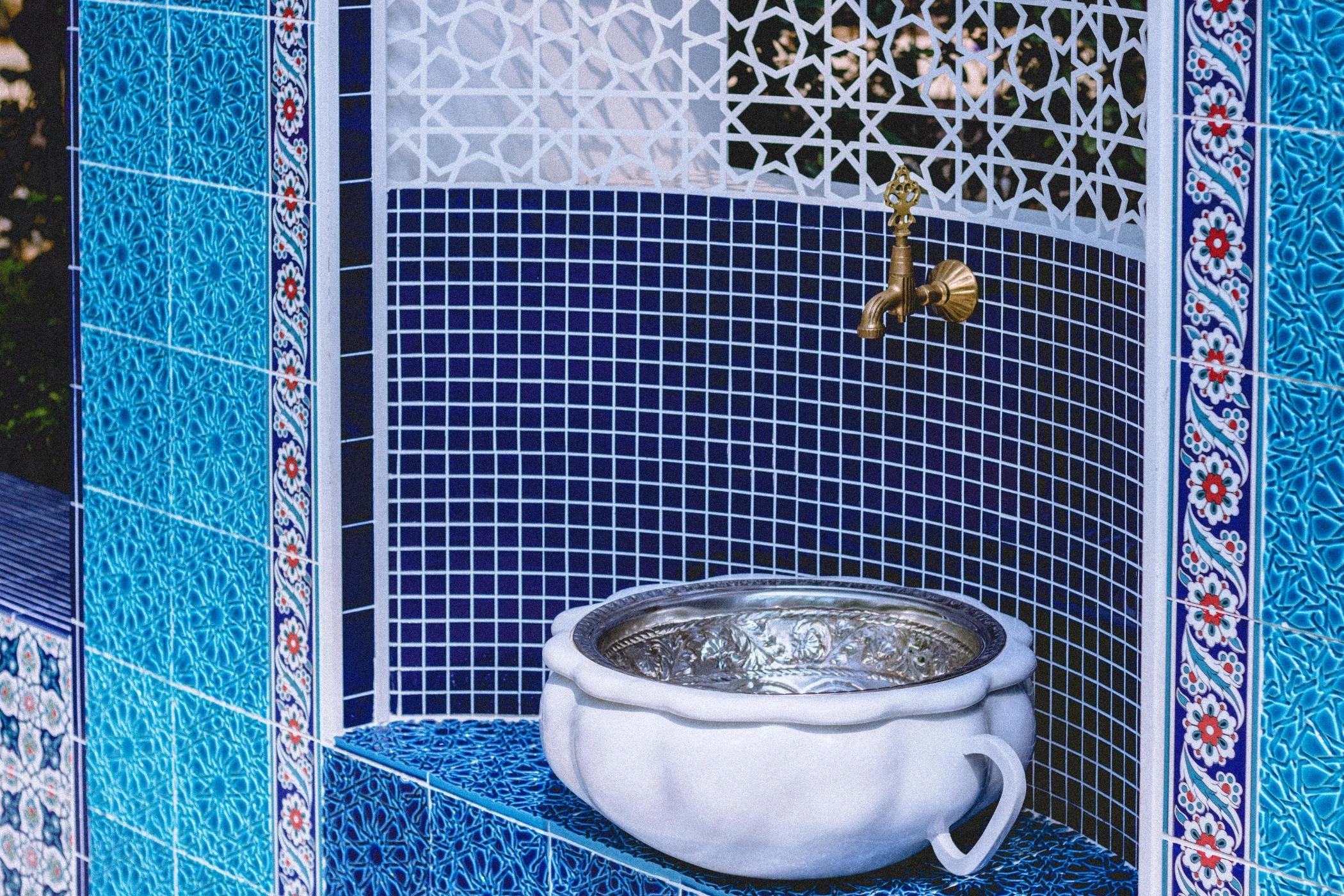
Mixing Moroccan Tiles with Modern Elements in Bathroom
Moroccan tiled bathroom ideas do not have to feel overly traditional. You can blend Moroccan tiles with modern elements to create a perfect balance between heritage and contemporary. Pairing bold patterns with sleek or minimalist vanities can allow the tiles to take center stage without overpowering the space.
Combining Moroccan tiles with natural materials like wood, brass, or marble can add warmth, resulting in a rich, layered beauty. To create a more dramatic effect, black Moroccan tiles can be paired with gold fixtures to create a Parisian-inspired look. Meanwhile, a blue Moroccan tile bathroom complemented by matte black accents can achieve a timeless feel. In the picture below, you can observe how moroccan wall tiles can be mixed and matched with brass fittings in a modern-day bathroom.
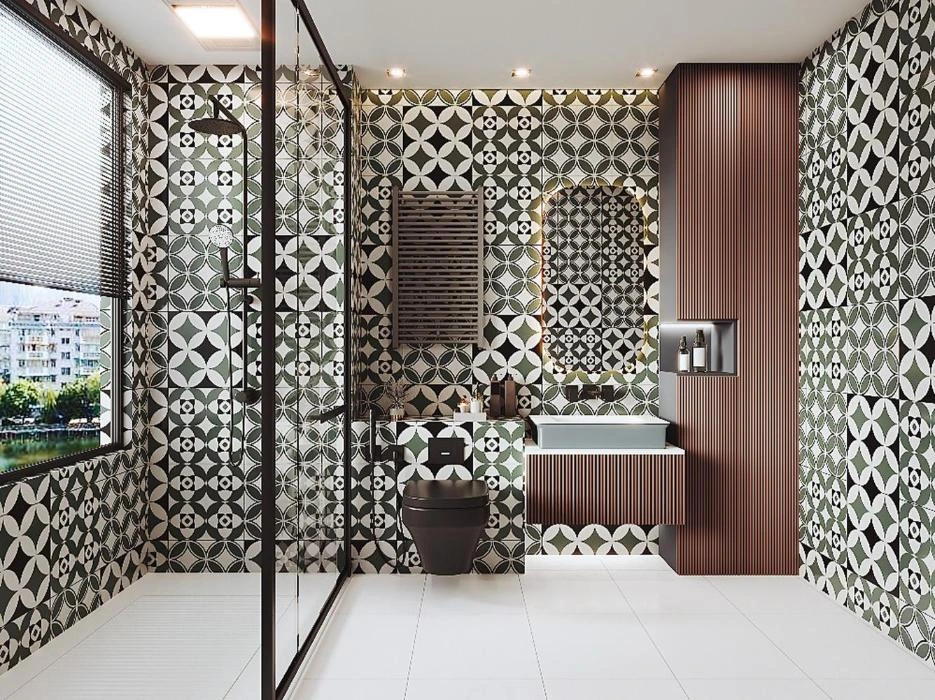
Choosing the Right Moroccan Tile Colors
Color plays a crucial role in setting the tone of a bathroom, and Moroccan tiles offer a stunning array of hues to suit different aesthetics. Whether you prefer bold, eye-catching shades or soft, earthy tones, the right color choice can transform your space into a striking retreat.
Bold & Vibrant Hues
Rich, eye-catching colors are a signature of Moroccan design. They bring energy and personality to a bathroom. Blues and greens bring relaxation, whereas terracotta or pink can bring vibrancy.
- Blue Tiles: Blue Moroccan tiles in the bathroom is a classic choice. The color of deep cobalt and turquoise blues evokes Mediterranean waters, creating a calming yet luxurious atmosphere. Below is an image of a blue Moroccan tile.
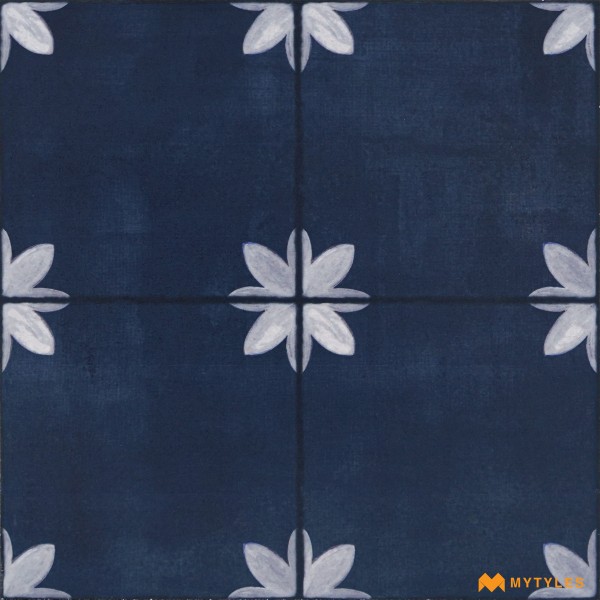
- Green Tiles: There are shades like emerald, sage, and jade in the color green. Green Moroccan tiles in the bathroom can add a fresh, organic feel, perfect for a nature-inspired or spa-like retreat. Below is an image of a green Moroccan tile.

- Pink Tiles: From soft blush to bold fuchsia, pink tiles in the bathroom can add warmth and a contemporary touch while also maintaining Moroccan charm. These can create a welcoming feel. Below is an image of a pink Moroccan tile.

- Terracotta & Rust: These shades of earthy color in the bathroom are trending for their raw, organic appeal. These warm tones can offer a rustic yet sophisticated look. Below is an image of a terracotta & rust Moroccan tile.

Earthy & Neutral Tones
A more subtle, modern look comes out with neutral Moroccan tiles. They can blend tradition with contemporary. Furthermore, whites and neutrals can keep the space light, open, and timeless.
- White Moroccan Tiles: White Moroccan tiles in the bathroom can give a crisp and clean look. White tiles create a bright and airy feel while highlighting intricate Moroccan patterns. Below is an image of a white Moroccan tile.

- Black Moroccan Tiles: Black tiles in a bathroom can add depth and contrast by being dramatic and bold. Black tiles can make a striking statement in both modern and traditional settings. Below is an image of a black Moroccan tile.

- Beige or Taupe: These colors in the bathroom offer warmth without overpowering a space. These soft and understated colors are ideal for minimalist and bohemian designs. Below is an image of a beige Moroccan tile.

- Warm Gray & Charcoal: Grey Moroccan tiles in the bathroom are modern yet classic. Charcoal and gray are two excellent options to achieve a sophisticated style with a Moroccan flair. Below is an image of a gray Moroccan tile.
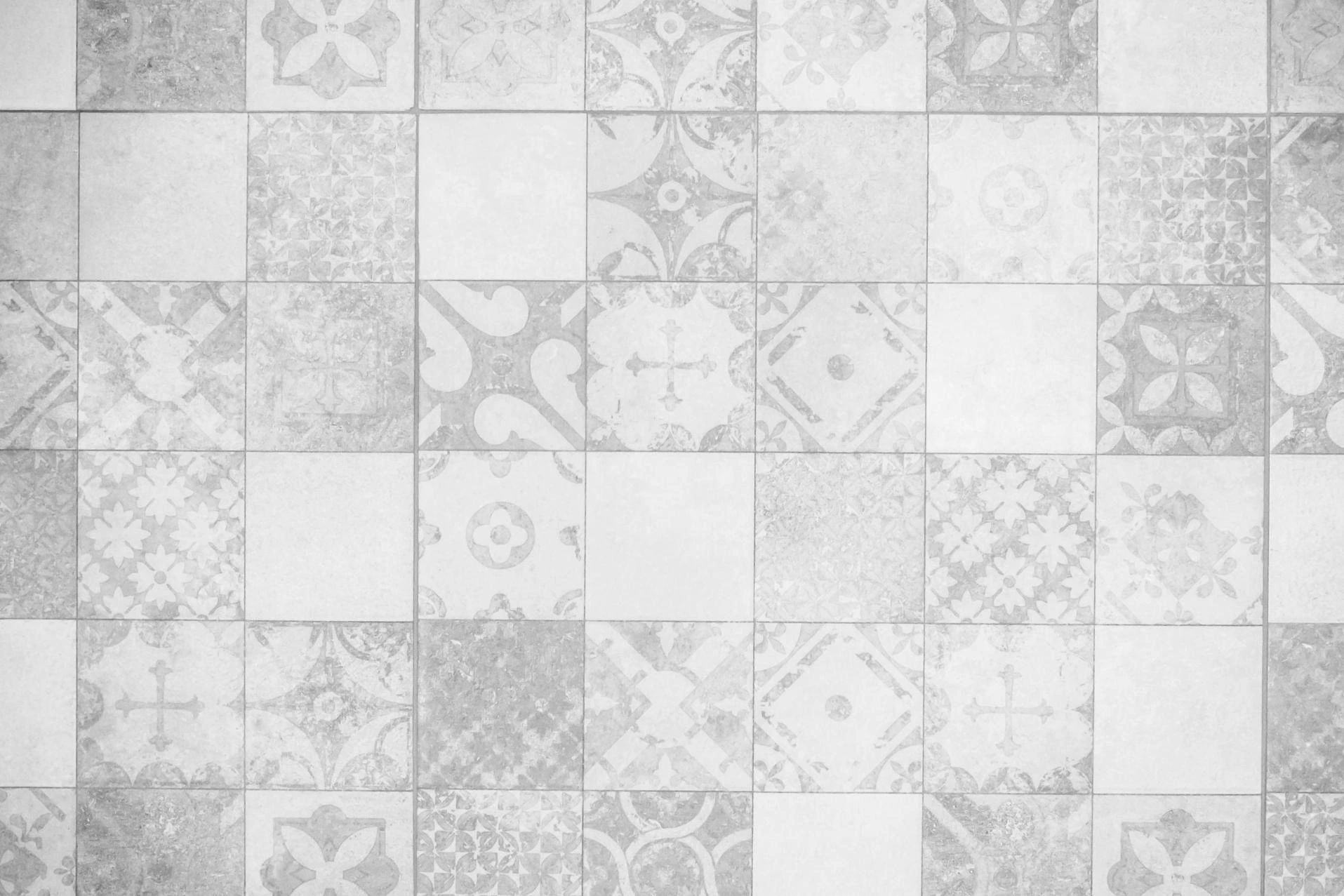
Combining Colors
Mixing colors can enhance depth and style. Thoughtful color combinations can help define different areas of the bathroom.
- Blue & White Moroccan Tiles: A blue and white bathroom with Moroccan tiles is the ideal coastal-inspired combination that feels fresh and breezy. Below is an image of a blue and white Moroccan tile.

- Green & Gold Moroccan Tiles: Green and gold is a rich, luxurious pairing that can add style and warmth to your bathroom. Below is an image of a green and gold Moroccan tile.
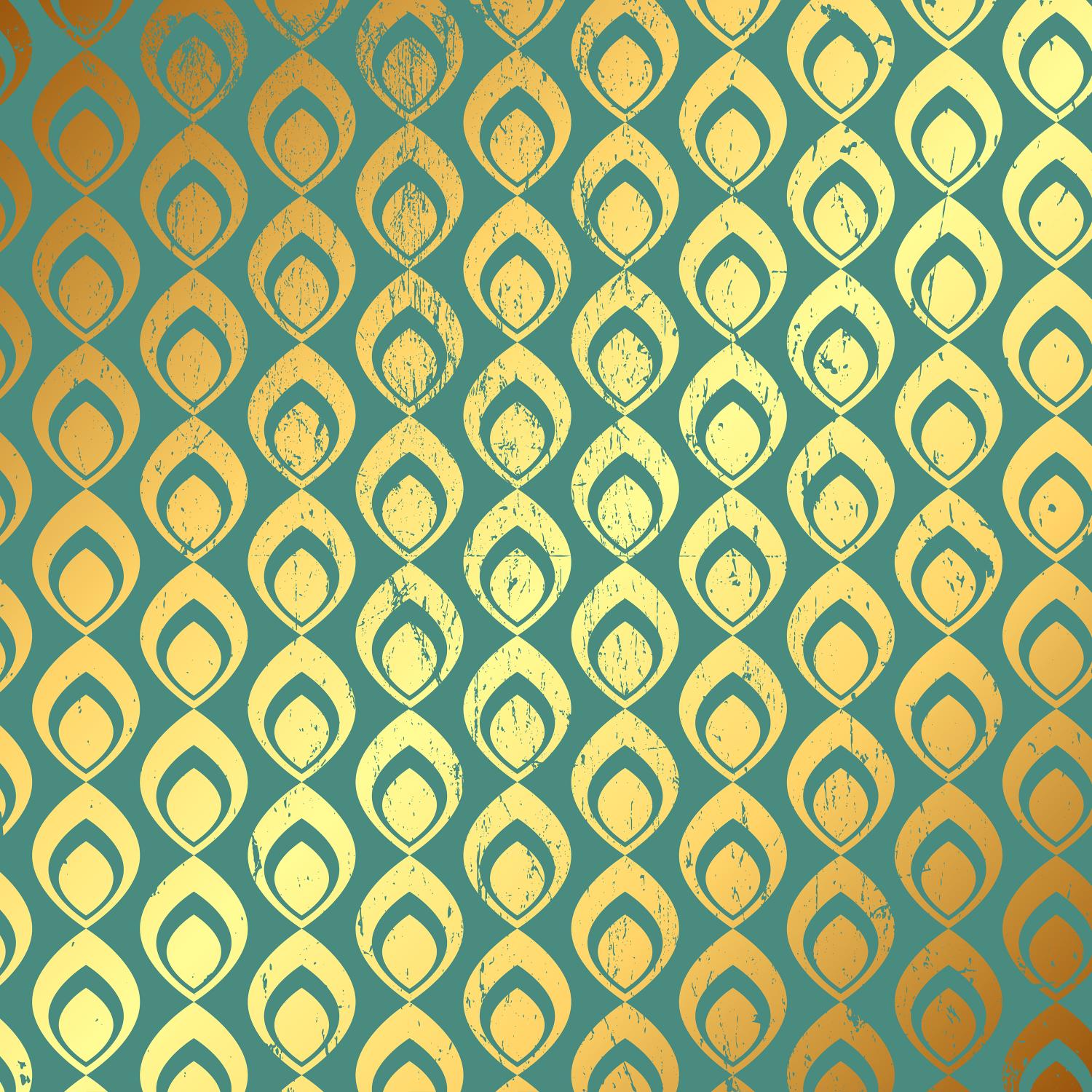
- Black & White Moroccan Tiles: Black and White Moroccan tiles in the bathroom is a bold, high-contrast look that suits both modern and classic spaces. Below is an image of a black and white Moroccan tile.

- Pink & Terracotta Moroccan Tiles: This palette is a trending combination for your bathroom that feels warm, earthy, and effortlessly chic. Below is an image of a pink & terracotta Moroccan tile.

Tile Inspirations for Different Bathroom Styles
One of the greatest strengths of Moroccan tile design is its versatility. It does not matter if you are going for a strong, classic look or something more subtle. Moroccan tiles can work with any style and give your bathroom personality.
Traditional Bathrooms
A traditional Moroccan bathroom can embrace rich colors, intricate patterns, and antique elements. Deep blues, greens, and terracotta Moroccan tiles set the foundation, while handmade tiles on backsplashes or shower walls can add an old-world charm. Brass or antique bronze fixtures can complement the historical aesthetic. Further Moroccan-style lanterns, arched mirrors, and carved wood accents can complete the look. In the picture below, you can observe a traditional terracotta-floored moroccan bathroom.
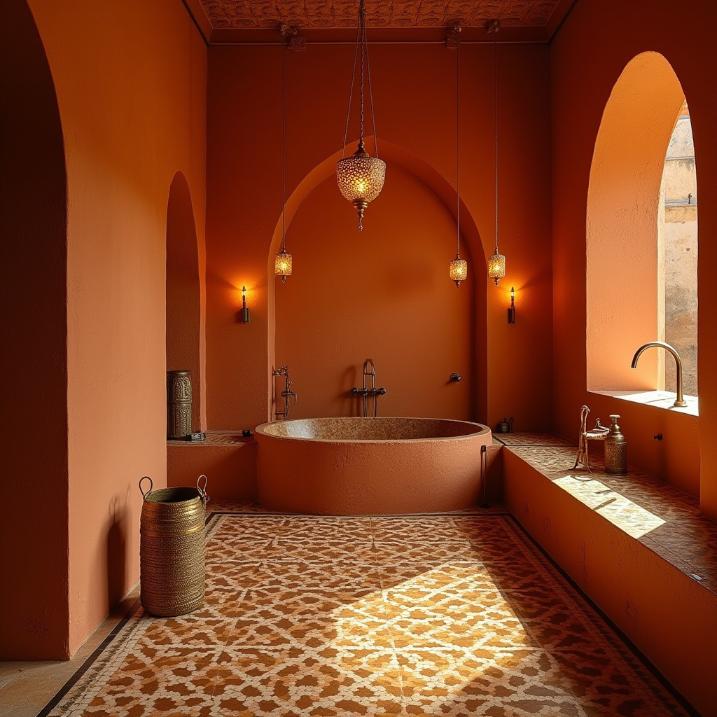
Minimalist & Contemporary Fusion
For a modern take, blending Moroccan artistry with a minimalist aesthetic can create a clean yet stylish design. Soft greys, whites, and beige Moroccan tiles can provide a subtle pattern. Pairing Moroccan floor tiles with sleek vanities and matte black or chrome fixtures can add a contemporary feel. Geometric and minimal patterns keep the look refined. Furthermore, accent tiles in shower niches or behind vanities can introduce just the right touch of Moroccan charm. Below is an image of a sleek, contemporary bathroom with black fixtures and a black-and-white moroccan accent wall.
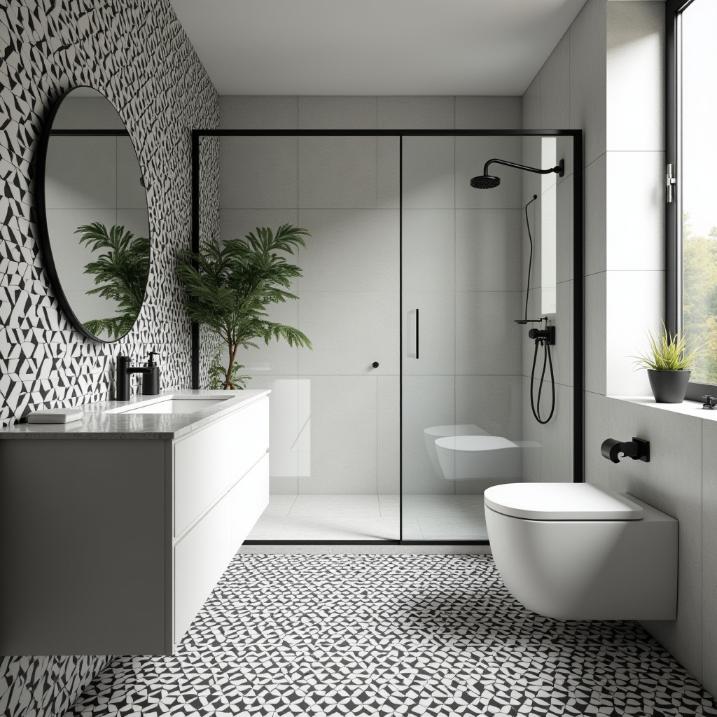
Rustic & Earthy Styles
A rustic Moroccan bathroom can combine natural elements, earthy tones, and handcrafted materials. Ochre, clay, and terracotta Moroccan floor tiles in the bathroom create warmth, while wood vanities, woven baskets, and stone basins bring in raw textures. To know more about adding texture to your bathroom, you can read the blog: How to Add Texture to Your Bathroom Using Tiles. Matte, unglazed Moroccan tiles help create the handcrafted look. Textured plaster or mud walls pair beautifully with Moroccan tile backsplashes and add to the organic feel. In the picture below, you can see Moroccan flooring with black and brick accent walls, creating a rustic look.
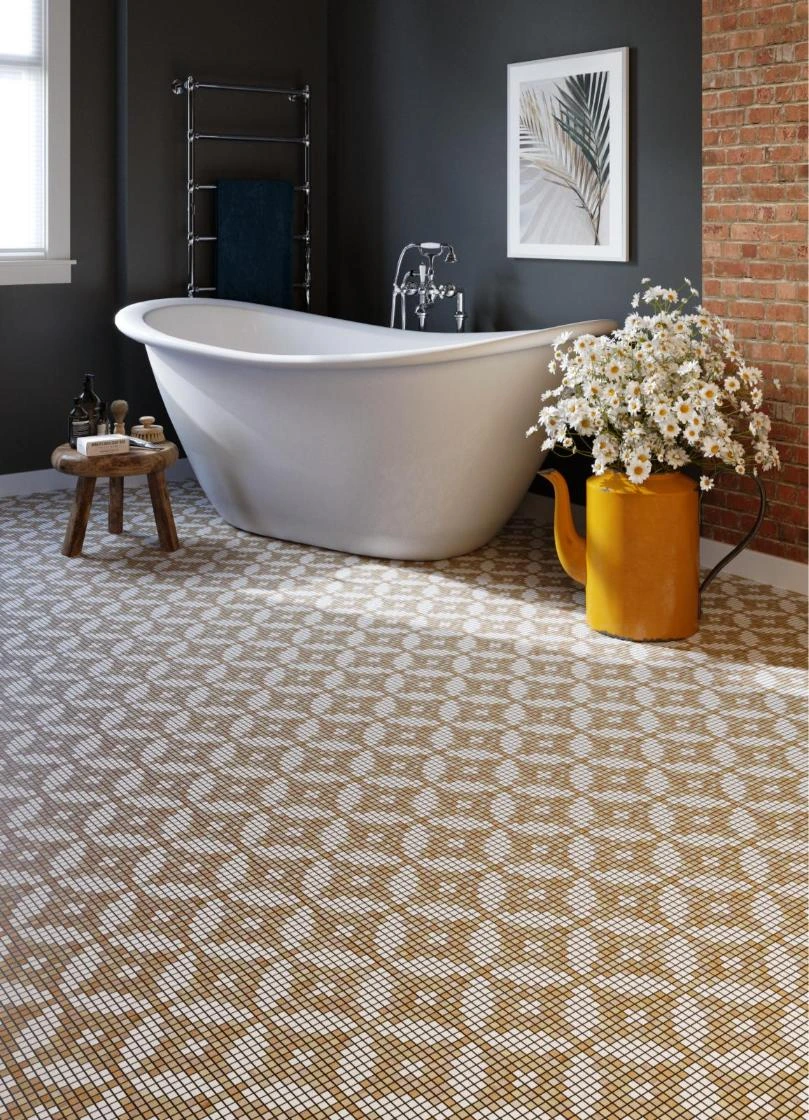
Luxury Spa-Like Bathrooms
A luxurious Moroccan bathroom focuses on soft hues, elegant details, and a calming ambiance. Blue Moroccan tiles can evoke a tranquil, water-like atmosphere, while white Moroccan tiles paired with gold fixtures can add a touch of opulence. Built-in seating and arched niches contribute to the hammam-inspired style. This makes the space feel high-end and deeply relaxing. Further, a soft, ambient lighting creates a soothing glow. Below is a picture of a luxurious spa-like bathroom with a Moroccan tiled design on the floor and brass basins.
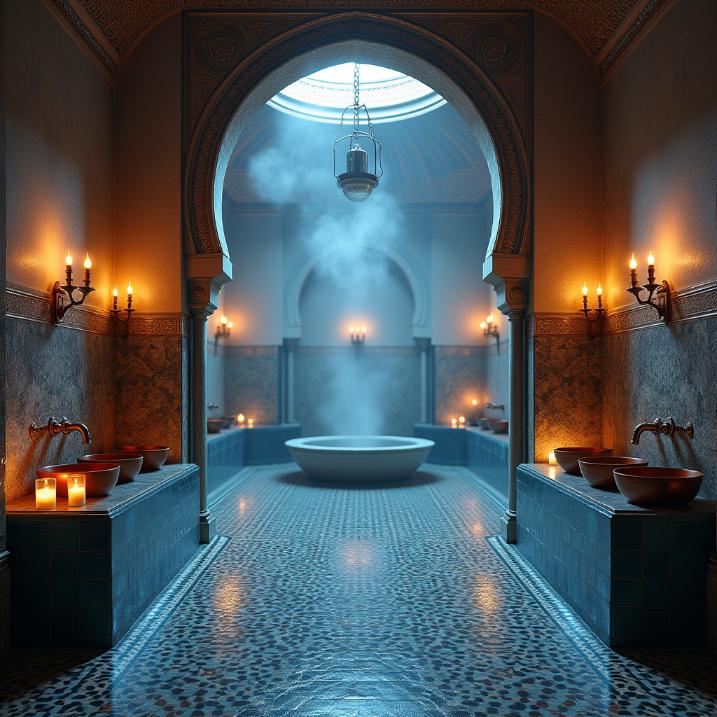
Bohemian Bathrooms
A bohemian Moroccan bathroom can blend eclectic patterns, layered textures, and free-spirited decoration. Mixing Moroccan tile patterns with rattan, macramé, and vintage wood creates a collected-over-time feel. Bold, mismatched Moroccan wall tiles in the bathroom add personality, while potted plants and colorful textiles bring out charm. Vintage or repurposed furniture as vanities can add character. Below is the picture of a Bohemian bathroom with moroccan floor tiles, wooden furnishings and beige curtains to complete the look.
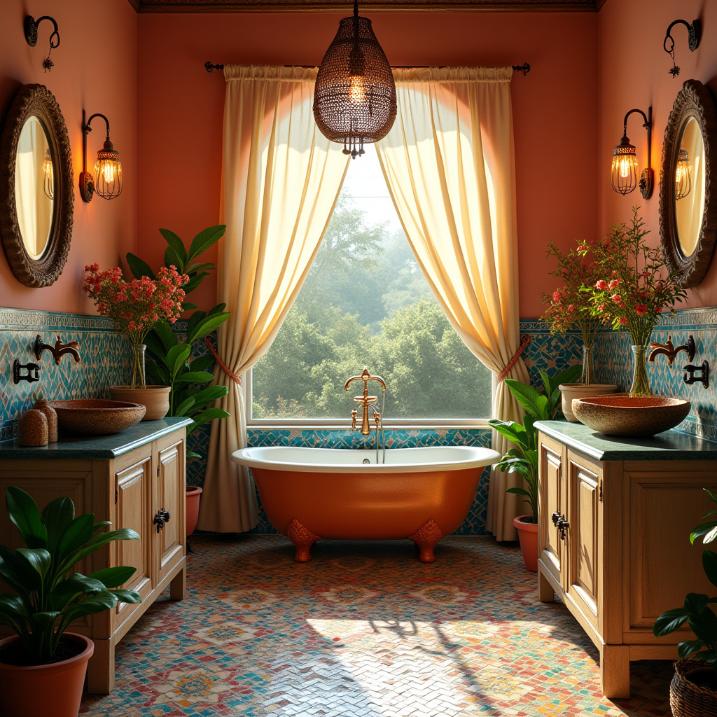
Industrial Bathrooms
A modern industrial Moroccan bathroom can combine the raw, edgy elements with artistic Moroccan touches. Black and white Moroccan tiles on the floor can be used as a contrast against exposed concrete or brick walls. Grey Moroccan tiles and matte black metal fixtures can give an urban aesthetic. Along with those hanging Edison bulbs, black hardware and open shelving can add to the minimalist appeal. You can look at the picture below with matching moroccan tiles on the floor and accent wall, with concrete walls creating a raw industrial look.
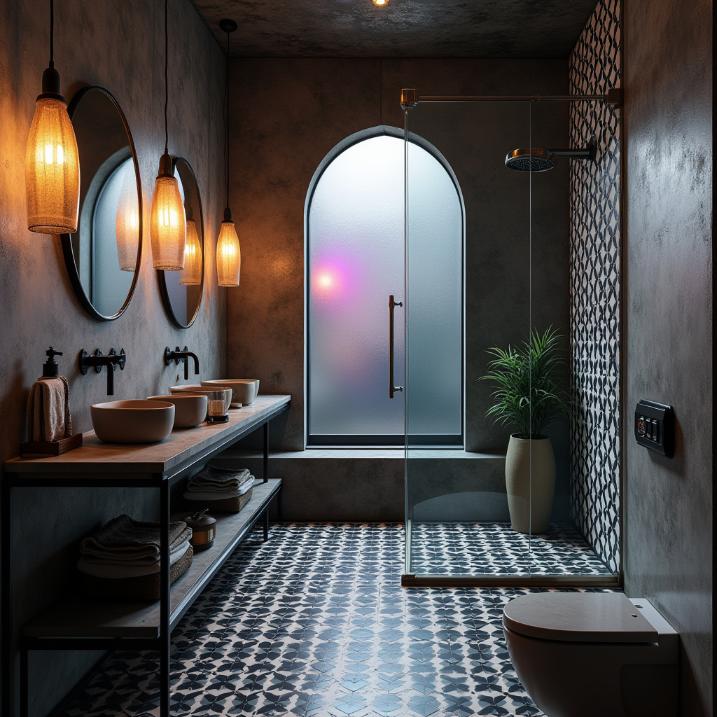
Coastal Mediterranean Bathrooms
A coastal Moroccan bathroom merges breezy, beachy aesthetics with Moroccan design influences. Blue Moroccan tiles paired with crisp white walls and sandy neutrals can create a fresh, airy vibe. White moroccan accent walls can brighten the space, while woven textures and light wood vanities amp up the relaxed, natural feel. Handmade ceramic or glass sinks can add an artisanal touch, completing a bathroom that feels serene. In the image below are blue moroccan tiles on the floor with white neutrals on the wall, creating an airy coastal bathroom with the plant completing the look.
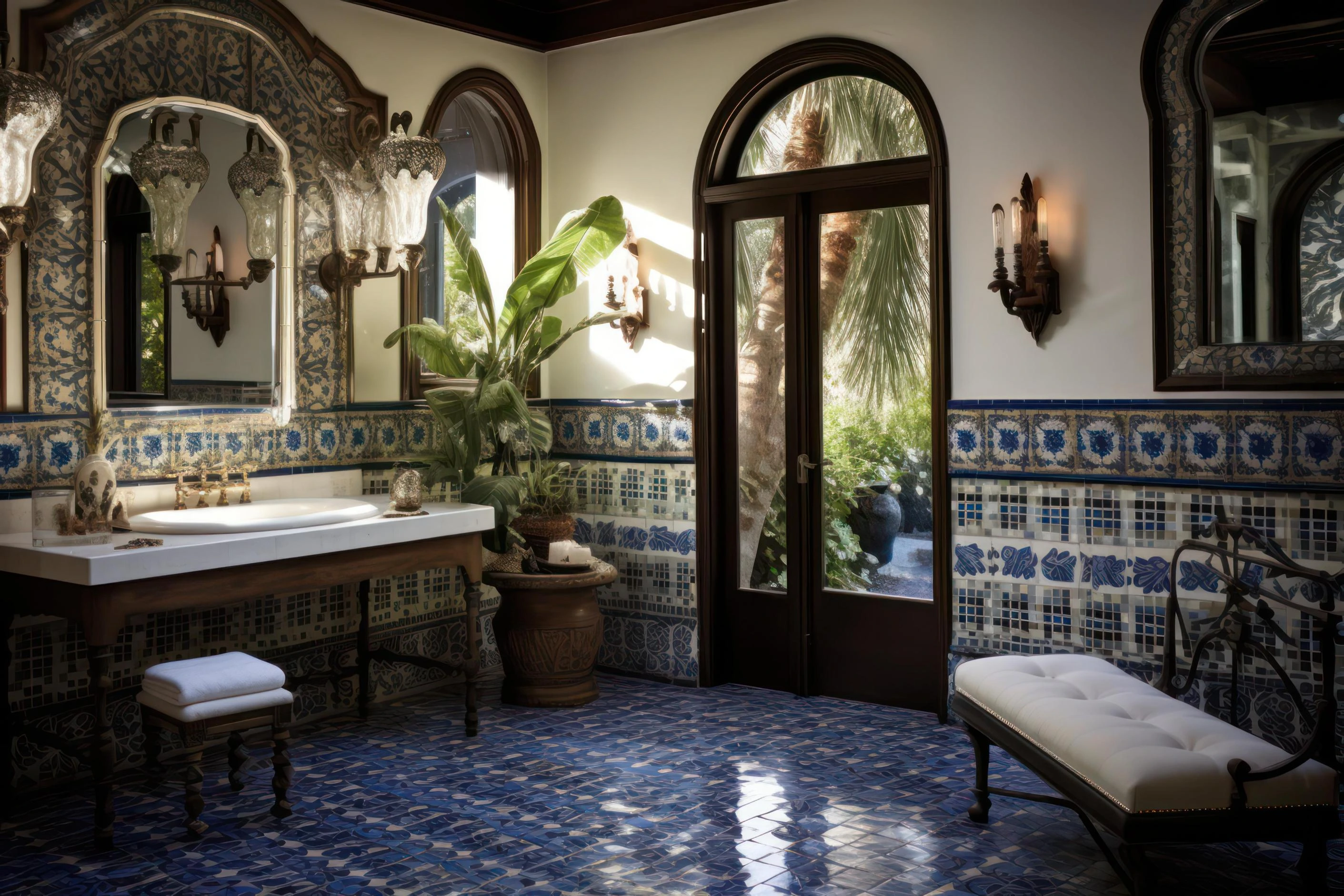
Why Moroccan Tiles Are Perfect for Your Bathroom
Moroccan tiles have long fascinated designers and homeowners, combining artistry, craftsmanship, and durability in a way few materials can match. Moroccan tiles in the bathroom designs bring in geometric patterns, intricate motifs, and rich color palettes. Whether used for statement flooring, accent walls, or detailed backsplashes, these tiles can bring warmth, character, and a sense of timeless beauty to any space.
What Makes Moroccan Tiles Unique?
The beauty, rich history, and adaptability of these handcrafted items set them apart from the rest.
- Handcrafted Beauty: Traditional Moroccan tiles are often handmade, which can result in slight variations, but they add depth and authenticity. Each tile carries a vintage charm, bringing texture and attractiveness to a bathroom.
- Timeless Appeal: These patterns, rooted in Moorish, Mediterranean, and Islamic design traditions, have remained relevant for centuries. Hence, they can help create a vintage-inspired retreat as well as a sleek, modern bathroom.
- Versatility in Application: From a bold black-and-white Moroccan tile contrast to the calming tones of blue or green, these tiles offer endless design possibilities, suiting all bathroom styles.
Care Tips for Long-Lasting Tiles
To have Moroccan tile in bathroom designs, proper maintenance is required to keep the tiles vibrant and long-lasting. While glazed ceramic and porcelain tiles require minimal care, Zellige and encaustic cement tiles can need extra attention. Here’s how to preserve their beauty.
- Regular Cleaning: You can use a pH-neutral, mild detergent to clean Moroccan tiles without damaging the glaze. Avoid harsh chemicals, which can fade colors and weaken the grout. Regular wiping with a soft cloth or mop can prevent dirt buildup.
- Protecting and Sealing Tiles: Encaustic cement and unglazed Zellige tiles can need periodic sealing to prevent water damage. Apply a penetrating sealant every 6 to 12 months to maintain durability. Glazed ceramic and porcelain tiles do not require sealing, making them a lower-maintenance choice.
- Grout Maintenance: Try to choose stain-resistant grout to prevent discoloration, like Epoxy grout. Clean grout lines with a baking soda paste or a gentle cleaner to avoid mold buildup. Applying a grout sealant periodically can protect against moisture and stains, keeping the tiles looking fresh.
- Preventing Scratches and Damage: Use soft sponges for cleaning instead of abrasive pads. For floor tiles, place felt pads under heavy furniture and use rugs in high-traffic areas to minimize wear. Furthermore, rotating rugs helps distribute foot traffic evenly and prevents fading.
- Avoid Heavy Impact: While Moroccan tiles are durable, dropping heavy objects on them can cause chipping or cracks. You need to handle them with care to maintain their intricate beauty. Try using protective pads to prevent accidental pressure points, especially on floor tiles.
Bestselling Moroccan Tiles at MyTyles
Here are a few best-selling Moroccan tile designs at MyTyles:
- Ceramic White and Black Moroccan Floor and Wall Code 29288 (300x300mm, Matt): This tile features intricate geometric patterns, a non-glare finish that gives it durability, slip resistance, and easy maintenance for both walls and floors.
- Ceramic Grey Moroccan Floor and Wall Tile Code 28241 (300x300mm, Matt): These tiles combine traditional elegance with modern durability for floors and walls. With minimal maintenance, it is perfect for residential and commercial spaces.
- Ceramic Ivory Moroccan Tile Code 25920 (300x300mm, Matt): Elevate your space with ceramic Ivory Moroccan Tile, blending classic charm with modern durability. Designed for both floors and walls; its matte finish makes it ideal. It ensures effortless elegance and easy upkeep.
- Ceramic Moroccan Tile Code 3264 (300x300mm, Matt): These can blend rustic colors with geometric elegance, featuring mosaic grid layouts and intricate detailing. With thirteen variations and a handcrafted feel, each tile installation is uniquely sophisticated.
- Ceramic White Moroccan Floor and Wall Tile Code 28935 (300x300mm, Matt): This type of tile features intricate designs and a sophisticated matte finish, bringing subtle elegance to any space These tiles work beautifully on walls, backsplashes, or feature areas.
- Vitrified Moroccan Tile Code 3310 (300x300mm, Matt): These tiles can combine a central motif with watercolor gradient backgrounds in charcoal or golden yellow, creating distinctive yet timeless focal points for any space. They are perfect for flooring, accent walls, or statement installations.
- Ceramic Moroccan Tile Code 17848 (300x300mm, Matt): These modern Mexican Talavera ceramic wall tiles feature a distinctive quatrefoil pattern with central motifs in teal, carmine, and mahogany tones, available in four unique prints per box for customizable mosaic layouts.
- Ceramic Moroccan Tile Code 22750 (300x300mm, Matt): This features a rich purple design with a matte finish. These versatile tiles are suitable for both floor and wall applications across living rooms, bedrooms, bathrooms, kitchens, and outdoor areas, with multiple layout options.
- Ceramic White and Black Moroccan Tile Code 31293 (300x300mm, Matt): The sophisticated matte finish of these ceramic tiles, designed for both interior and exterior use, enhances any space, including living rooms, bedrooms, bathrooms, kitchens, and outdoor areas.
- Ceramic Moroccan Tile Code 3266 (300x300mm, Matt): Moroccan wall and floor tile features sectional arcs, fleur-de-lis patterns, and a matte glaze in vibrant ethnic colors. Inspired by hydraulic cement, its stormy grays and encaustic designs add charm to kitchens, bathrooms, and outdoor spaces.
- Ceramic Moroccan Tile Code 22248 (300x300mm, Matt): These feature intricate medallions and lattice patterns with floral and golden details. They are available in three variations: pastel summer hues, Mediterranean blue, and terracotta brown, and can enhance backsplashes and living spaces.
Bringing Moroccan Elegance Into Your Bathroom Space
Moroccan tiles are a celebration of art, culture, and craftsmanship. Their vibrant patterns, intricate details, and historical charm have the power to transform any bathroom into a visually stunning space. Moroccan tile in the bathroom can bring warmth and character that few materials can match, whether used in small accents or as a bold statement. They can serve as striking flooring, accent walls, or shower backdrops, adding depth and personality to any space.
With proper selection and maintenance, these tiles are not only beautiful but also durable. If you are planning a bathroom transformation, Moroccan tiles can provide the perfect opportunity to create a unique space. You can envision a luxurious spa retreat, a rustic, earthy escape, or a contemporary fusion of cultures; these tiles can bring it all to life with their distinct charm. At MyTyles, you can get this historical, elegant, and adaptable tile.
FAQs on Moroccan Tile in Bathroom Ideas
Q. What are some popular Moroccan tile bathroom ideas?
Ans. Moroccan tile bathroom ideas often include bold geometric patterns, intricate mosaics, and vibrant color schemes. Many designs feature accent walls, decorative flooring, and strategically placed tile backsplashes that combine traditional Moroccan artistry with modern fixtures.
Q. How can I incorporate Moroccan tiles into my bathroom design?
Ans. You can incorporate Moroccan tiles by using them on accent walls, as floor tiles, in shower niches, or as decorative details. They work well when mixed with modern or minimalist elements, providing a unique blend of heritage and contemporary style.
Q. What colors work best with Moroccan tiles in bathrooms?
Ans. Popular color choices include vibrant hues like deep blue, turquoise, and green, as well as neutral tones such as grey, black and white, or crisp white. The selection depends on whether you want a bold, energetic space or a more subtle, sophisticated ambiance.
Q. Are Moroccan tiles suitable for high-moisture areas like bathrooms?
Ans. Yes, many Moroccan tiles are suitable for bathrooms. Glazed ceramic and vitrified options are particularly moisture-resistant. However, tiles such as encaustic cement or unglazed zellige require proper sealing to protect against water damage.
Q. How do I maintain Moroccan tiles in a bathroom setting?
Ans. Maintenance involves regular cleaning with pH-neutral cleaners, gentle wiping with soft cloths or mops, and, for certain types like unglazed Zellige or cement tiles, periodic sealing to prevent staining and moisture absorption.
Q. What types of Moroccan tiles are best for bathrooms?
Ans. Common choices include Zellige tiles for their handcrafted charm, encaustic cement tiles for bold patterns, and glazed ceramic or porcelain tiles for durability and moisture resistance, each offering a unique aesthetic and functional benefit.
Q. Can Moroccan tiles be used on bathroom floors?
Ans. Yes, Moroccan floor tiles are a popular option. They can create intricate, eye-catching patterns that serve as a focal point, though it’s important to ensure they’re installed with slip-resistant finishes and maintained properly in wet environments.
Q. Do Moroccan tiles require sealing in bathrooms?
Ans. Some Moroccan tiles, such as unglazed Zellige and encaustic cement tiles, do require sealing to prevent water absorption and staining. Glazed ceramic and porcelain tiles, however, typically do not need sealing, making them a lower-maintenance choice.
Q. How do I choose the right Moroccan tile colors for my bathroom?
Ans. Choosing the right colors depends on your desired atmosphere. For a vibrant look, opt for deep blues, greens, or terracotta hues. If you prefer a modern, minimalist vibe, consider neutral palettes like grey, black and white, or pure white Moroccan tiles.
Q. What bathroom styles work best with Moroccan tiles?
Ans. Moroccan tiles complement various bathroom styles, including traditional setups with rich, antique elements; minimalist designs with neutral palettes; rustic spaces that feature earthy tones and natural textures; luxury spa-like bathrooms with soft hues and elegant fixtures; as well as eclectic bohemian or industrial aesthetics.
